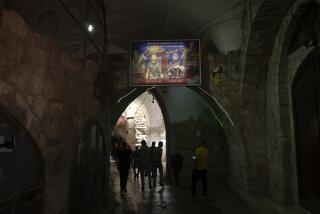File Details Iraqi Unit’s Role in Dozens of Assassinations
BAGHDAD — The Iraqi Intelligence Service established a unit to assassinate Saddam Hussein’s enemies at home and abroad that claimed 66 successful “operations” between 1998 and 2000, according to documents obtained by The Times.
Found on the floor of a looted Intelligence Service villa on the east bank of the Tigris River here, the six-page file described the program and contained suggestions for improving its effectiveness -- including obtaining poisonous gas disguised as perfume or explosives that would detonate when the car of the target passed by.
None of the assassination targets was specified in the documents, dated April and May 2000, but the period mentioned was a time when prominent Shiite leaders were killed in suspicious circumstances in Iraq and a number of Iraqi dissidents abroad were at least targeted.
Though short on details, the file provides insight to the inner workings of the feared Mukhabarat, with its memorandum that asks for recommendations for improving its assassination apparatus, and a response recommending a division of “quality control.” The documents said the project was code-named “Al Ghafiqi.” In Arabic, the code sounds like a person’s name, but its significance was not clear.
In a working paper attached to the file, the author -- known only by a coded designation -- refers to the “fulfillment” of 17 missions in 1998, 35 in 1999 and 14 in the first three months of 2000. It was not clear precisely when the program began or when, or whether, it ended.
“The assigned tasks were fulfilled precisely and without any mistake, and the project achieved the thanks and appreciation of the director of the Intelligence Service,” the working paper said.
The head of the Intelligence Service at the time was Tahir Abdal Jalil Habbush Tikriti, who remained in his post until the fall of the Hussein government this month.
He is now a fugitive from the U.S. armed forces and is the jack of diamonds on the U.S. military’s deck of most-wanted Iraqis. The papers appear to corroborate the long-standing accusation that Hussein sanctioned assassinations of his opponents abroad. In the most famous case, the Mukhabarat plotted to assassinate former President George H.W. Bush during a visit to Kuwait in 1993.
Former Iraqi officer Mohammed Ali Ghani told London’s Sunday Telegraph newspaper that Iraqi intelligence agents had tried to force him in July 1999 to try to assassinate the leader of the Iraqi National Accord, one of the main anti-Hussein groups. He said he did not comply.
One of Iraq’s most prominent Shiite Muslim leaders, Grand Ayatollah Muhammad Sadr, was killed along with two of his sons on Feb. 19, 1999. In 1998, two prominent ayatollahs also were assassinated in the Iraqi city of Najaf.
The documents said the missions of the Al Ghafiqi project were carried out by individuals from within the Intelligence Service and by some outside it, including the paramilitary Fedayeen Saddam and the Military Intelligence Service, most recently headed by Gen. Zahayr Naqib.
Before his surrender to a U.S. military officer Wednesday, Naqib was interviewed by The Times and asked whether military intelligence had indeed helped to carry out assassinations.
“It is not true,” he said, maintaining that the documents possessed by The Times were in error.
The file obtained by The Times begins with an “Administrative Order” on the stationery of the Iraqi Intelligence Service dated April 26, 2000, discussing the formation of a four-member committee to oversee the project.
The person designated to head the committee was Khudair Ismail Ibrahim, with the coded designation M-D1/M4. Nothing further about him was immediately known.
“By the authority of the director of the Intelligence Service ... an oversight committee is to be formed presided by Mr. Khudair Ismail Ibrahim and the members mentioned to assume responsibility to implement the suggestions of the working paper concerning the tasks and duties of Al Ghafiqi project and to promote the necessary recommendations,” said the order, signed by an unnamed assistant on behalf of the head of the Iraqi Intelligence Service.
Three other members of the committee were named: Kamil Daham Saoud, Zuhair Tariq Abdul-Razaq and Ihsan Ali Abdullah.
The attached working paper makes clear that the purpose of the Al Ghafiqi project is assassination. It says that the project already had obtained some of its required devices, including silencers for guns and remote-controlled explosives, and says, “Further plans are being developed.”
The working paper -- titled “Suggestions” -- urges specialized training for the project’s Intelligence Service members “to develop their capabilities both inside and outside the country” and to get members acquainted with the project’s results.
It also urges taking advantage of the technical knowledge, manuals and skills of other branches of the Intelligence Service.
The document said the members of the project should report directly to the head of the Intelligence Service “to guarantee the secrecy of the work.” It said a specialized cadre of operatives should be used, “relying on quality rather than quantity” of personnel.
It also suggested raising the project to the level of a directorate, rather than a division, to guarantee its independence and give it greater spending authority.
It said the directorate should have mechanical, electronic and chemical divisions, as well as one for “quality control.” Attached to the file was a memorandum from the director asking for other suggestions, and one reply marked “confidential” that said the Al Ghafiqi project should endeavor to make use of new technologies and unorthodox weapons.
Among those suggestions:
* “Provide high-tech equipment, especially remote-control explosives.”
* “Use new forms and unconventional ones, such as camouflaged poisonous gas that could be in the form of perfume or placed inside a book or other personal items,” said an operative signed only as “division head.”
* Arrange shipments of booby-trapped weapons and ammunition to “traitorous groups” in Kurdish-controlled northern Iraq trying to buy arms on the Iraqi black market.
* Perfect technology to allow a transmitter to be placed on a target’s car that would detonate camouflaged explosive material when the car passed near. The document said explosive devices should be able to be detonated by radio signals sent from between 500 yards and about three miles away.
A separate document, found in the same vicinity as the Al Ghafiqi project papers and dated Oct. 13, 2002, listed 84 people in Europe, the United States and Arab countries under surveillance by Iraqi intelligence.
They included Abdul Ameer Taba Tabahi, a prominent London-based Shiite leader; Azad Najib Talabani, a London-based Kurdish opponent to the regime; and Ismael Kadry, a British-based critic of Hussein who frequently speaks on international radio broadcasts.
Times staff writers Michael Slackman and Sergei L. Loiko contributed to this report.
More to Read
Sign up for Essential California
The most important California stories and recommendations in your inbox every morning.
You may occasionally receive promotional content from the Los Angeles Times.










